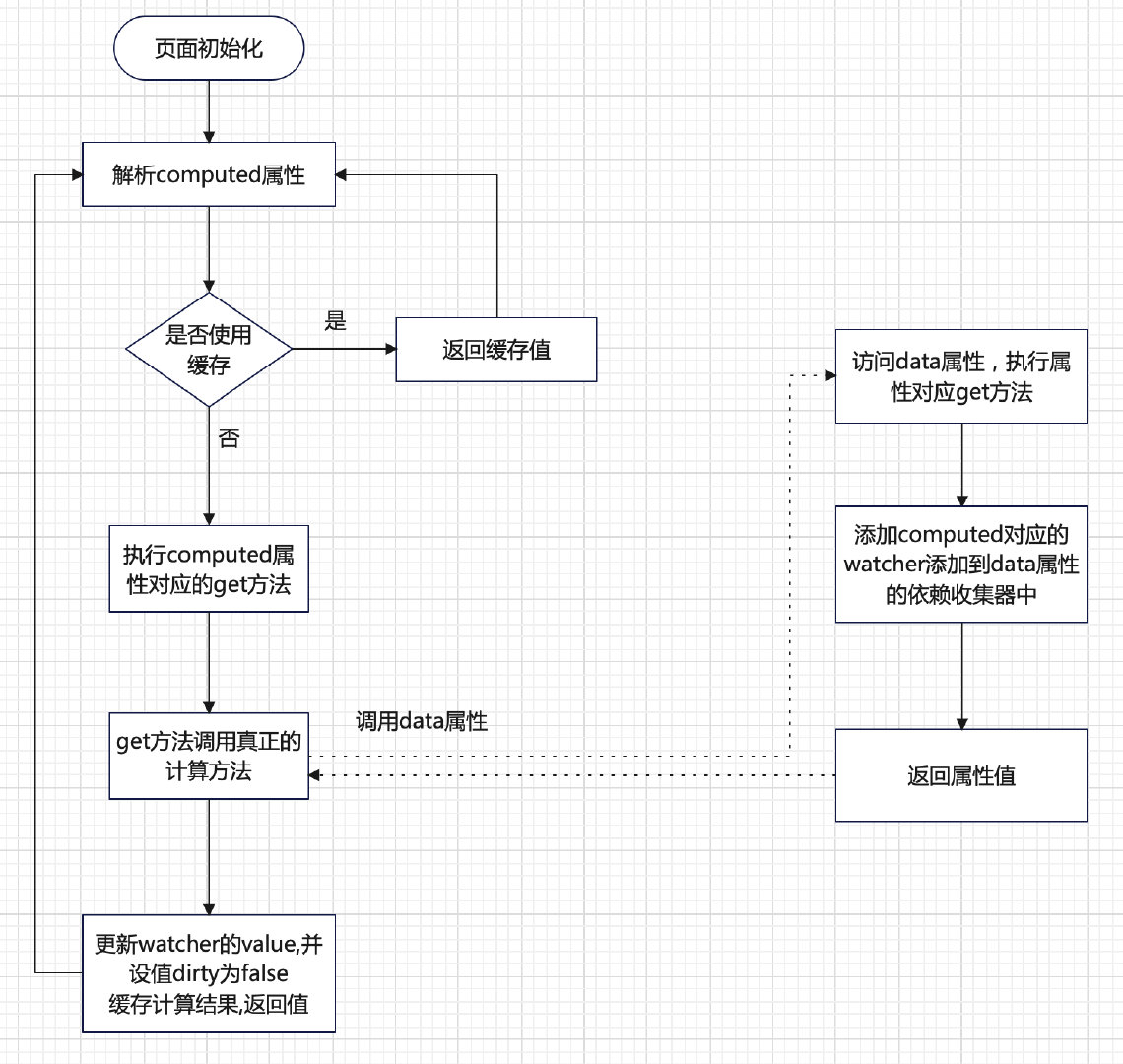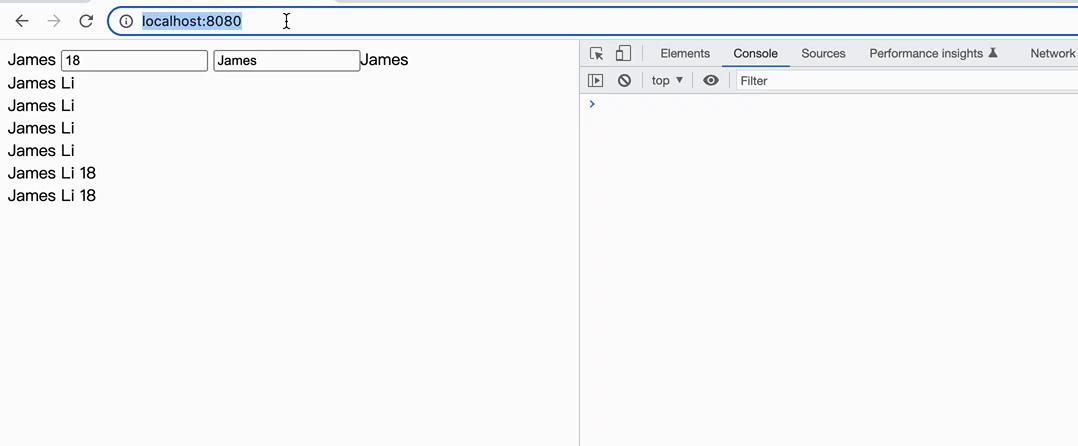基於vue2.0原理-自己實現MVVM框架之computed計算屬性
基於上一篇data的雙向繫結,這一篇來聊聊computed的實現原理及自己實現計算屬性。
一、先聊下Computed的用法
寫一個最簡單的小demo,展示使用者的名字和年齡,程式碼如下:
<body>
<div id="app">
<input type="text" v-model="name"><br/>
<input type="text" v-model="age"><br/>
{{NameAge}}
</div>
<script>
var vm = new MYVM({
el: '#app',
data: {
name: 'James',
age:18
},
computed:{
NameAge(){
return this.$data.name+" "+this.$data.age;
}
},
})
</script>
</body>
執行結果:

從程式碼和執行效果可以看出,計算屬性NameAge依賴於data的name屬性和age屬性。
特點:
1、計算屬性是響應式的
2、依賴其它響應式屬性或計算屬性,當依賴的屬性有變化時重新計算屬性
3、計算結果有快取,元件使用同一個計算屬性,只會計算一次,提高效率
4、不支援非同步
適用場景:
當一個屬性受多個屬性影響時就需要用到computed
例如:購物車計算價格
只要購買數量,購買價格,優惠券,折扣券等任意一個發生變化,總價都會自動跟蹤變化。
二、原理分析
1、 computed 屬性解析
每個 computed 屬性都會生成對應的觀察者(Watcher 範例),觀察者存在 values 屬性和 get 方法。computed 屬性的 getter 函數會在 get 方法中呼叫,並將返回值賦值給 value。初始設定 dirty 和 lazy 的值為 true,lazy 為 true 不會立即 get 方法(懶執行),而是會在讀取 computed 值時執行。
function initComputed(vm, computed) {
// 存放computed的觀察者
var watchers = vm._computedWatchers = Object.create(null);
//遍歷computed屬性
for (var key in computed) {
//獲取屬性值,值可能是函數或物件
var userDef = computed[key];
//當值是一個函數的時候,把函數賦值給getter;當值是物件的時候把get賦值給getter
var getter = typeof userDef === 'function' ? userDef: userDef.get;
// 每個 computed 都建立一個 watcher
// 建立watcher範例 用來儲存計算值,判斷是否需要重新計算
watchers[key] = new Watcher(vm, getter, {
lazy: true
});
// 判斷是否有重名的屬性
if (! (key in vm)) {
defineComputed(vm, key, userDef);
}
}
}
程式碼中省略不需要關心的程式碼,在initComputed中,Vue做了這些事情:
-
為每一個computed建立了watcher。
-
收集所有computed的watcher,並繫結在Vue範例的_computedWatchers 上。
-
defineComputed 處理每一個computed。
2、將computed屬性新增到元件範例上
function defineComputed(target, key, userDef) {
// 設定 set 為預設值,避免 computed 並沒有設定 set
var set = function(){}
// 如果使用者設定了set,就使用使用者的set
if (userDef.set) set = userDef.set
Object.defineProperty(target, key, {
// 包裝get 函數,主要用於判斷計算快取結果是否有效
get:createComputedGetter(key),
set:set
});
}
// 重定義的getter函數
function createComputedGetter(key) {
return function computedGetter() {
var watcher = this._computedWatchers && this._computedWatchers[key];
if (watcher) {
if (watcher.dirty) {
// true,懶執行
watcher.evaluate(); // 執行watcher方法後設定dirty為false
}
if (Dep.target) {
watcher.depend();
}
return watcher.value; //返回觀察者的value值
}
};
}
-
使用 Object.defineProperty 為範例上computed 屬性建立get、set方法。
-
set 函數預設是空函數,如果使用者設定,則使用使用者設定。
-
createComputedGetter 包裝返回 get 函數。
3、頁面初始化時
頁面初始化時,會讀取computed屬性值,觸發重新定義的getter,由於觀察者的dirty值為true,將會呼叫原始的getter函數,當getter方法讀取data資料時會觸發原始的get方法(資料劫持中的get方法),將computed對應的watcher新增到data依賴收集器(dep)中。觀察者的get方法執行完後,更新觀察者的value,並將dirty置為false,表示value值已更新,之後執行觀察者的depend方法,將上層觀察者也新增到getter函數中data的依賴收集器(dep)中,最後返回computed的value值;

4、當 computed 屬性 getter 函數依賴的 data 值改變時
將會根據之前依賴收集的觀察者,依次呼叫觀察者的 update 方法,先呼叫 computed 觀察者的 update 方法,由於 lazy 為 true,將會設定觀察者的 dirty 為 true,表示 computed 屬性 getter 函數依賴的 data 值發生變化,但不呼叫觀察者的 get 方法更新 value 值。再呼叫包含頁面更新方法的觀察者的 update 方法,在更新頁面時會讀取 computed 屬性值,觸發重定義的 getter 函數,此時由於 computed 屬性的觀察者 dirty 為 true,呼叫該觀察者的 get 方法,更新 value 值,並返回,完成頁面的渲染。

5、核心流程
- 首次讀取 computed 屬性值時,dirty 值初始為 true
- 根據getter計算屬性值,並儲存在觀察者value上並設定dirty為false
- 之後再讀取 computed 屬性值時,dirty 值為 false,不呼叫 getter 重新計算值,直接返回觀察者中的value
- 當 computed 屬性getter依賴的data發生變化時,再次設定dirty為true,通知頁面更新,重新計算屬性值
三、自定義實現
基於上一篇文章實現的自定義框架,增加computed屬性的解析和繫結。
1、首先在index.html定義並使用計算屬性
<body>
<div id="app">
<span v-text="name"></span>
<input type="text" v-model="age">
<input type="text" v-model="name">
{{name}}<br/>
{{fullName}}<br/>
{{fullName}}<br/>
{{fullName}}<br/>
{{fullName}}<br/>
{{fullNameAge}}<br/>
{{fullNameAge}}<br/>
</div>
<script>
var vm = new MYVM({
el: '#app',
data: {
name: 'James',
age:18
},
//定義計算屬性
computed:{
fullName(){
return this.$data.name+" Li";
},
fullNameAge(){
return this.$computed.fullName+" "+this.$data.age;
}
},
})
</script>
</body>
</html>
定義了兩個計算屬性fullName和fullNameAge,並在模板中進行了呼叫。
2、MYVM.js中增加對計算屬性的解析和處理
function MYVM(options){
//屬性初始化
this.$vm=this;
this.$el=options.el;
this.$data=options.data;
//獲取computed屬性
this.$computed=options.computed;
//定義管理computed觀察者的屬性
this.$computedWatcherManage={};
//檢視必須存在
if(this.$el){
//新增屬性觀察物件(實現資料挾持)
new Observer(this.$data)
new ObserverComputed(this.$computed,this.$vm);
// //建立模板編譯器,來解析檢視
this.$compiler = new TemplateCompiler(this.$el, this.$vm)
}
}
增加$computed屬性用來儲存計算屬性,$computedWatcherManage用來管理計算屬性的Watcher,ObserverComputed用來劫持計算屬性和生成對應的watcher。
3、ObserverComputed建立computed的Watcher範例,劫持computed屬性
//資料解析,完成對資料屬性的劫持
function ObserverComputed(computed,vm){
this.vm=vm;
//判斷computed是否有效且computed必須是物件
if(!computed || typeof computed !=='object' ){
return
}else{
var keys=Object.keys(computed)
keys.forEach((key)=>{
this.defineReactive(computed,key)
})
}
}
ObserverComputed.prototype.defineReactive=function(obj,key){
//獲取計算屬性對應的方法
let fun=obj[key];
let vm=this.vm;
//建立計算屬性的Watcher,存入到$computedWatcherManage
vm.$computedWatcherManage[key]= new ComputedWatcher(vm, key, fun);
let watcher= vm.$computedWatcherManage[key];
Object.defineProperty(obj,key,{
//是否可遍歷
enumerable: true,
//是否可刪除
configurable: false,
//get方法
get(){
//判斷是否需要重新計算屬性
//dirty 是否使用快取
//$computedWatcherManage.dep 是否是建立Watcher收集依賴時執行
if(watcher.dirty || vm.$computedWatcherManage.dep==true){
let val=fun.call(vm)
return val
}else{
//返回Watcher快取的值
return watcher.value
}
},
})
}
vm.$computedWatcherManage[key]= new ComputedWatcher(vm, key, fun);建立Watcher範例
其它的註釋都比較細緻,不細說了哈
4、ComputedWatcher 快取value,管理頁面訂閱者,更新頁面
//宣告一個訂閱者
//vm 全域性vm物件
//expr 屬性名
//fun 屬性對應的計算方法
function ComputedWatcher(vm, expr,fun) {
//初始化屬性
this.vm = vm;
this.expr = expr;
this.fun=fun;
//計算computed屬性的值,進行快取
this.value=this.get();
//是否使用快取
this.dirty=false;
//管理模板編譯後的訂閱者
this.calls=[];
}
//執行computed屬性對應的方法,並進行依賴收集
ComputedWatcher.prototype.get=function(){
//設定全域性Dep的target為當前訂閱者
Dep.target = this;
//獲取屬性的當前值,獲取時會執行屬性的get方法,get方法會判斷target是否為空,不為空就新增訂閱者
this.vm.$computedWatcherManage.dep=true
var value = this.fun.call(this.vm)
//清空全域性
Dep.target = null;
this.vm.$computedWatcherManage.dep=false
return value;
}
//新增模板編譯後的訂閱者
ComputedWatcher.prototype.addCall=function(call){
this.calls.push(call)
}
//更新模板
ComputedWatcher.prototype.update=function(){
this.dirty=true
//獲取新值
var newValue = this.vm.$computed[this.expr]
//獲取老值
var old = this.value;
//判斷後
if (newValue !== old) {
this.value=newValue;
this.calls.forEach(item=>{
item(this.value)
})
}
this.dirty=false
}
ComputedWatcher核心功能:
1、計算computed屬性的值,進行快取
2、執行computed的get方法時進行依賴收集,ComputedWatcher作為監聽者被新增到data屬性或其它computed屬性的依賴管理陣列中
3、模板解析識別出計算屬性後,呼叫addCall向ComputedWatcher新增監聽者
4、update方法獲執行computed計算方法呼叫,遍歷執行依賴陣列的函數更新檢視
5、TemplateCompiler解析模板函數的修改
// 建立模板編譯工具
function TemplateCompiler(el,vm){
this.el = this.isElementNode(el) ? el : document.querySelector(el);
this.vm = vm;
if (this.el) {
//將對應範圍的html放入記憶體fragment
var fragment = this.node2Fragment(this.el)
//編譯模板
this.compile(fragment)
//將資料放回頁面
this.el.appendChild(fragment)
}
}
//是否是元素節點
TemplateCompiler.prototype.isElementNode=function(node){
return node.nodeType===1
}
//是否是文位元組點
TemplateCompiler.prototype.isTextNode=function(node){
return node.nodeType===3
}
//轉成陣列
TemplateCompiler.prototype.toArray=function(arr){
return [].slice.call(arr)
}
//判斷是否是指令屬性
TemplateCompiler.prototype.isDirective=function(directiveName){
return directiveName.indexOf('v-') >= 0;
}
//讀取dom到記憶體
TemplateCompiler.prototype.node2Fragment=function(node){
var fragment=document.createDocumentFragment();
var child;
//while(child=node.firstChild)這行程式碼,每次執行會把firstChild從node中取出,指導取出來是null就終止迴圈
while(child=node.firstChild){
fragment.appendChild(child)
}
return fragment;
}
//編譯模板
TemplateCompiler.prototype.compile=function(fragment){
var childNodes = fragment.childNodes;
var arr = this.toArray(childNodes);
arr.forEach(node => {
//判斷是否是元素節點
if(this.isElementNode(node)){
this.compileElement(node);
}else{
//定義文字表示式驗證規則
var textReg = /\{\{(.+)\}\}/;
var expr = node.textContent;
if (textReg.test(expr)) {
expr = RegExp.$1;
//呼叫方法編譯
this.compileText(node, expr)
}
}
});
}
//解析元素節點
TemplateCompiler.prototype.compileElement=function(node){
var arrs=node.attributes;
this.toArray(arrs).forEach(attr => {
var attrName=attr.name;
if(this.isDirective(attrName)){
//獲取v-text的text
var type = attrName.split('-')[1]
var expr = attr.value;
CompilerUtils[type] && CompilerUtils[type](node, this.vm, expr)
}
});
}
//解析文位元組點
TemplateCompiler.prototype.compileText=function(node,expr){
CompilerUtils.text(node, this.vm, expr)
}
CompilerUtils = {
/*******解析v-model指令時候只執行一次,但是裡面的更新資料方法會執行n多次*********/
model(node, vm, expr) {
if(vm.$data[expr]){
var updateFn = this.updater.modelUpdater;
updateFn && updateFn(node, vm.$data[expr])
/*第n+1次 */
new Watcher(vm, expr, (newValue) => {
//發出訂閱時候,按照之前的規則,對節點進行更新
updateFn && updateFn(node, newValue)
})
//檢視到模型(觀察者模式)
node.addEventListener('input', (e) => {
//獲取新值放到模型
var newValue = e.target.value;
vm.$data[expr] = newValue;
})
}
},
/*******解析v-text指令時候只執行一次,但是裡面的更新資料方法會執行n多次*********/
text(node, vm, expr) {
//判斷是否是data屬性
if(vm.$data[expr]){
/*第一次*/
var updateFn = this.updater.textUpdater;
updateFn && updateFn(node, vm.$data[expr])
/*第n+1次 */
new Watcher(vm, expr, (newValue) => {
//發出訂閱時候,按照之前的規則,對節點進行更新
updateFn && updateFn(node, newValue)
})
}
//認為是計算屬性
else{
this.textComputed(node,vm,expr)
}
},
//新增text computed屬性的解析方法
textComputed(node, vm, expr) {
var updateFn = this.updater.textUpdater;
//獲取當前屬性的監聽者
let watcher=vm.$computedWatcherManage[expr];
//第一次
updateFn(node,vm.$computed[expr]);
//新增更新View的回撥方法
watcher.addCall((value)=>{
updateFn(node, value);
})
},
updater: {
//v-text資料回填
textUpdater(node, value) {
node.textContent = value;
},
//v-model資料回填
modelUpdater(node, value) {
node.value = value;
}
}
}
這個函數主要做了2點修改:
1、修改text方法,如果data裡不包含該屬性,當做計算屬性處理
2、新增textComputed方法,把該節點的更新函數新增到watcher的依賴陣列
6、為該框架增加一個簡易的計算屬性就完成了,下面看下執行效果:

初始化的時候會輸出:fullName 1 fullNameAge 1 fullName 1
先解釋fullName 1為什麼輸出2次?
fullName和fullNameAge都是計算屬性。
fullNameAge依賴於fullName,fullName依賴與data的屬性name
Index.html中有輸出了四個fullName計算屬性,實際fullName計算屬性只執行了一次計算,把值快取了下來,剩餘3個直接取快取的值。輸出第二個fullName 1是因為fullNameAge依賴與fullName,需要把fullNameAge的監聽者新增到data的屬性name的依賴陣列中,這樣name屬性有更新的時候會執行到fullNameAge的監聽函數。
ok,自己實現的這部門還有改進空間,有能力的朋友幫忙改進哈!不明白的朋友可以加好友一起交流。